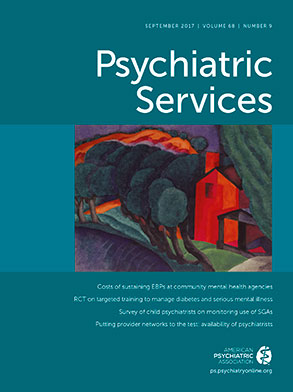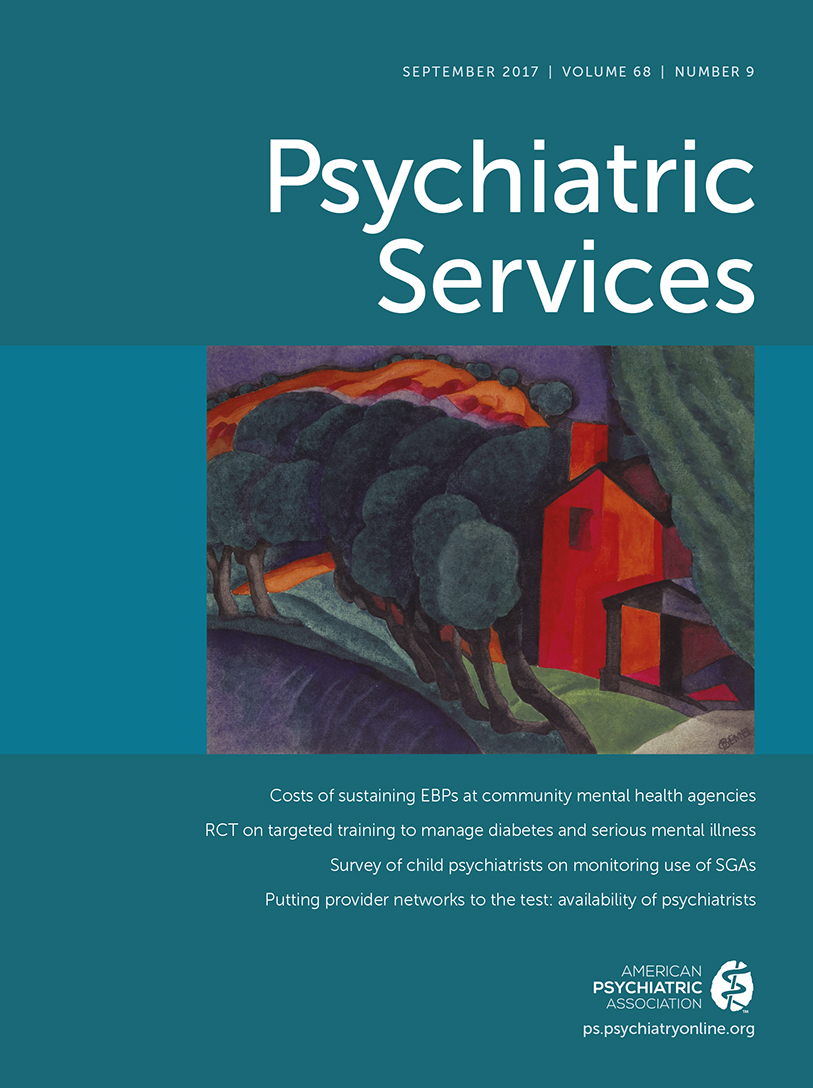Despite the passage and implementation of the Affordable Care Act (ACA) and the Paul Wellstone and Pete Domenici Mental Health Parity and Addiction Equity Act of 2008, significant problems remain in relation to mental health care availability and access to mental health treatment for individuals in the United States. Although there are approximately 107 million individuals in the United States with a mental disorder or substance use disorder, representing approximately 34% of the U.S. population (
1–
3), only about four in ten adults and fewer than five in ten children with a mental disorder received treatment in the past year (
4).
In a recent meta-analysis of over 36,000 individuals, researchers found that 62% of individuals with identified mental illnesses did not receive any mental health care. They also found that persons with mental illness were less likely to have adequate insurance and more likely to experience barriers to care compared with those without mental illness (
5). In another recent study, adolescent psychiatrist availability was examined by using the “mystery shopper” methodology; the average wait times for new patient appointments was found to be 46 days (
6,
7). Few studies have been conducted to examine whether the adult population has adequate access to mental health treatment. One study examined four health insurance carriers on the Maryland Health Connection (the state-sponsored insurance exchange) in 2014, both in terms of the accuracy of the plan’s description and the adequacy of the plan. The study also utilized the “mystery shopper” approach. In this study, callers were able to reach only 43% of the 1,154 psychiatrists listed on the exchange, and only 14% of the listed psychiatrists were actually accepting new outpatient appointments within a 45-day time frame (
8).
More recently, the Sentinel Project at Seton Hall Law School evaluated the status of access to mental health care in New Jersey. The project identified multiple problems with behavioral health services access in the state, but the primary issue was a lack of transparency in network directories and drug formularies, which directly hindered the ability of patients to obtain adequate health care (
9).
The goal of this study was to determine the accuracy of three major insurance carriers’ public databases of psychiatrists within a 30-mile radius of Washington, D.C. The study also evaluated new patient appointment availability and average wait times by using the “mystery shopper” approach.
Methods
A cross-sectional study of the publicly listed network of psychiatrists for three of the four largest insurance carriers that serve the Washington, D.C., area was conducted. The contact information for the network psychiatrists was found on each insurance carrier’s general provider directory list posted on the carriers’ publicly available Web sites. We searched the online provider directories for each carrier (hereafter denoted as carriers A, B, and C) for all listed psychiatrists located within a 30-mile radius of zip code 20010; the directory for carrier C could not be searched by using a 30-mile radius, so a 20-mile radius was used instead. The lists were searched for psychiatrists with the same name, phone number, and office location to eliminate duplicate psychiatrists at the same practice setting. If a psychiatrist practiced in more than one setting with a different phone number, the listings were not considered duplicates and were not eliminated.
The online search of provider directories identified 1,184 psychiatrists (carrier A, N=500; carrier B, N=499; and carrier C, N=185), providing the sampling frame for this study. For each carrier list, a total of 50 psychiatrists were randomly selected to be contacted. A total of 14 contacts (9%) were identified as duplicates with the same name, phone number, and office location (but on different carrier plans); 78 (52%) of contacts were duplicate names with different practice locations, phone numbers, and insurance plans.
Six research assistants were trained to follow a strict data collection protocol by using an online survey tool developed specifically for this study. Data were collected between February and March 2016 and were analyzed in April 2016. The names of the selected psychiatrists were split randomly among the six research assistants. On the Monday of the study week, each of the selected psychiatrists was telephoned by a research assistant. If the call went unanswered, a voice mail was left when possible, and follow-up calls were made if the call was returned by the psychiatrist’s office. If a psychiatrist was listed more than once on a single caller’s list—for example, the same psychiatrist was sampled for two different carriers—the duplicate was moved to another caller’s list to minimize a caller’s risk of calling the same contact multiple times in one day.
The primary measures assessed whether the contact information listed on the carrier’s Web site was correct, whether the psychiatrist accepted the insurance carrier listed, whether the psychiatrist currently accepted new outpatients for the insurance carrier, and the soonest available appointment date for a new outpatient with the carrier’s insurance. If any one of the questions received a negative response, the caller was instructed to end the call at that point and submit the collected data. All calls were made during normal business hours between 8 a.m. and 5 p.m.
The callers were instructed to inquire about making an appointment for a family member, using generic language as much as possible. If they were asked for more details, they were instructed to say that they were trying to find the earliest appointment date for a family member who needed to be seen by a psychiatrist. If an appointment date was offered, the research assistant was instructed to tell the office before actually scheduling an appointment that he or she would check his or her schedule and call back at a later time. If the research assistants were asked for the patient’s presenting problem, they were instructed to indicate that they believed the family member may either be depressed, experiencing panic attacks, or have an eating disorder. If the receptionist indicated that a referral from a primary care physician was needed to schedule an appointment, the callers were instructed to indicate that the family member had already seen a primary care physician, who suggested that the family member see a psychiatrist. The research assistants reported having used one of the three clinical scenarios during calls to 13 of the 150 (9%) psychiatrists.
At the end of each day of calling, the results were evaluated by the study coordinator. An individual contact was deemed nonviable if any of the following occurred: the phone number was disconnected, the contact information was incorrect and the practice could not provide another correct phone number, the physician did not accept the health insurance listed, the provider was not a board-certified psychiatrist, or the psychiatrist was not currently accepting any new outpatient appointments with the listed carrier. The nonviable contacts were then removed from the caller lists, and the remaining contacts were called again on Wednesday of that week. The same process and protocol was followed. The nonviable contacts were removed from the call lists and the remaining contacts were called on the Friday of that week. The study week was considered complete on the following Monday. Any returned voice mails were immediately acted upon throughout the study week, and information was recorded. This process was repeated for each carrier, for a total of three study weeks (one week per carrier).
After the study was completed, statistical analyses were performed by using SUDAAN, release 11.1. Chi-square tests were performed to test for statistically significant differences between carriers in overall distribution of categorical values. The study coinvestigators reviewed all call data and accompanying notes for internal consistency.
Results
Table 1 summarizes outcomes for the key study measures. Overall, 77% of the offices could be successfully contacted, meaning someone on the other end picked up the phone or returned voice mail messages left by the research associates. There were no statistically significant differences between insurance carriers with regard to rates of successfully contacting the offices of psychiatrists listed in the carriers’ directory. For approximately half of the listed network psychiatrists (51%), the contact information was correct and the caller was able to verify that the physician listed worked at that location.
With regard to acceptance of new outpatients, 15% of psychiatrists across all three carriers were accepting new outpatient appointments. The proportion of psychiatrists accepting new outpatient appointments from the carrier was lowest (4%) for carrier A and highest for carrier B (26%).
In terms of scheduling new outpatient appointments, only 14% of psychiatrists were able to offer an appointment date for a new outpatient. The mean wait time across all three insurance carriers from the initial contact with the physicians’ offices to the first available new outpatient appointment was 19 days. Only 7% of sampled psychiatrists overall were able to schedule an appointment within a two-week period after the initial phone call, with only 2% of carrier A network psychiatrists having been able to schedule an appointment during this time period.
Discussion
Our findings highlight significant barriers for patients in obtaining access to psychiatric treatment from three of the largest health insurance carriers in the Washington, D.C., metropolitan area. Only 14% of the psychiatrists in the publicly listed networks were able to offer new outpatient appointments, with a mean waiting time of 19 days; only 7% of listed psychiatrists overall were able to offer a new outpatient appointment within two weeks.
Previous studies have focused on how financial barriers to mental health treatment affect parity with other fields of medicine (
10–
12). However, this study shows that another major consideration related to mental health access is the accuracy of insurance carrier provider directory lists and the availability of physicians listed. This issue has direct implications for patient access to mental health treatment; the use of erroneous physician databases may direct patients to purchase plans that appear to have robust lists of clinicians, even though many of the listed physicians may not be available to provide adequate and timely care.
The primary limitation of this study was its focus on one metropolitan area and three insurance carriers within a 30-mile radius of Washington, D.C. However, these three insurance carriers are responsible for insuring a majority of insured individuals in the region (
www.naic.org/prod_serv/MSR-HB-16.pdf). Another limitation was that there was no external validation of whether the psychiatrists accepted the insurance.
Conclusions
The recent landmark ACA and federal parity mental health legislation was designed to bring about parity between access to and coverage for mental health treatment and other areas of medicine. However, timely access to mental health care remains a serious challenge. The inaccuracy of psychiatrist databases for insurance carriers may be a major contributor to mental health treatment access problems, and further research is needed to examine the issue nationally.

